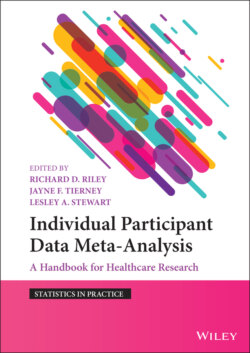Читать книгу Individual Participant Data Meta-Analysis - Группа авторов - Страница 99
4.9 Merging IPD Ready for Meta‐Analysis
ОглавлениеAfter verification, the finalised dataset for each trial is ready to be used within subsequent IPD meta‐analyses. At this stage, it is helpful to merge the final IPD from all trials into a single dataset. Although statistical methods for IPD meta‐analysis can still be applied if trial datasets are located locally in different files, a single dataset that houses all the IPD is more convenient and potentially makes analyses faster. For example, Box 1.1 (Chapter 1) shows an example dataset containing IPD from 10 trials after data checking, harmonisation, verification and merging. Most statistical packages, such as Stata, SAS and R, have built‐in commands for merging datasets from different files, and these generally require the datasets to share common variable names, which will have been achieved at the data harmonisation stage (Section 4.5.3). Not all variables in every trial dataset need to be merged, and the statistician can restrict the variables to just those to be used in particular statistical analyses. It is important to check that no errors are introduced when merging the datasets. Therefore, it is sensible to calculate summary statistics (e.g. number of participants in each group, mean age, proportion of women, overall treatment effect) for each trial before (in the pre‐merge dataset) and after (in the merged dataset), to ensure they agree exactly. A single dataset comprising IPD from all trials will not be achievable if the IPD for some can only be accessed remotely, but the central research team can still proceed with a two-stage meta‐analysis as described in Chapter 5.
Figure 4.13 Example of items to include in summary of finalised trial IPD for verification by a trial investigator.
Source: Ruth Walker and Lesley Stewart.
